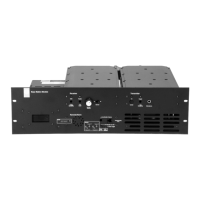C3.12 T854 Initial Tuning and Adjustment M8SL2-00-002-812
© Copyright Tait Electronics Limited August 2004. All rights reserved.
4. Change the input frequency back to 300Hz.
Repeat steps 2 and 3 above until the deviations achieved at the two input frequen-
cies are within 0.2dB of each other. You will need to do this at least four times.
5. Sweep the audio between 50 and 300Hz for peaks.
Note: A peak between 50 and 300Hz will indicate a fault condition, i.e:
– incorrect set-up
or – modulation circuitry fault.
The specification window is ±1dB relative to 150Hz from 67 to 260Hz.
3.9.3 CTCSS Encoder (If Used)
1. Program a CTCSS tone on the default channel using PGM800Win.
2. If you are using an RF test set, turn off the 300Hz high pass filter.
3. Key the T854 with the front panel “Carrier” switch.
4. Adjust RV805 (CTCSS level adjust) to give ±500Hz (±350Hz) [±250Hz] deviation.
5. Set the maximum deviation as per Section 3.9.4.
3.9.4 Limiter Adjustment
Note: If the T854 will be used over the whole 8MHz switching range, you must set
the deviation for each channel. However, if the module will be used on fre-
quencies that cover only a 1MHz (or less) switching range, you can set the
deviation on the middle channel and use this value for all other channels
with the “EPOT Fill” option in PGM800Win.
1. Set the links in the audio processor section as required (refer to Section 3.5).
2. Inject 1kHz at –10dBm into the line input (D-range 1 (PL100) pins 1 and 4; and
pins 2 and 3 shorted; refer to Section 1.5 of Part G).
3. Adjust RV210 (line sensitivity) fully clockwise and key the transmitter by earthing
the Tx-Key line. Using PGM800Win, adjust the value of the “Deviation” EPOT set-
ting for the current channel to obtain a deviation limit of ±4.7kHz (±3.8kHz)
[±2.3kHz] (you can use either the mouse or up and down arrow keys).
4. Sweep the audio frequency from 100Hz to 4kHz and ensure that the maximum
deviation does not exceed ±4.7kHz (±3.8kHz) [±2.3kHz]. Readjust “Deviation” if
necessary via PGM800Win.

